Annual Ryegrass (Lolium rigidum), Wild Oats (Avena spp.) and Sowthistle (Sonchus oleraceus) Are the Most Commonly Occurring Weeds in New South Wales Cropping Fields
Abstract
:1. Introduction
2. Materials and Methods
2.1. Random Surveys
2.2. Data Collection
2.3. Data Analysis
3. Results
3.1. Occurrence and Density of Major Weed Species
3.2. Weed Species Diversity and Associations
3.3. Crop Species
4. Discussion
5. Conclusions
Supplementary Materials
Author Contributions
Funding
Data Availability Statement
Acknowledgments
Conflicts of Interest
References
- Oerke, E.C. Crop losses to pests. J. Agric. Sci. 2006, 144, 31–43. [Google Scholar] [CrossRef]
- McLeod, R. Annual Costs of Weeds in Australia; eSYS Development Pty Limited. Published by the Centre for Invasive Species Solutions: Canberra, Australia, 2018. [Google Scholar]
- Llewellyn, R.S.; Ronning, D.; Ouzman, J.; Walker, S.R.; Mayfield, A.; Clarke, M. Impact of Weeds on Australian Grain Production: The Cost of Weeds to Australian Grain Growers and the Adoption of Weed Management and Tillage Practices; CSIRO: Canberra, Australia, 2016. [Google Scholar]
- ABARES. Australian Commodity Statistics. Available online: http://www.daff.gov.au/abares (accessed on 18 March 2021).
- NSW Department of Planning Industry and Environment. Digital Soil Mapping of Key Soil Properties over NSW; Technical Report; NSW OEH: Sydney, NSW, Australia, 2018.
- NSW Department of Planning Industry and Environment. Australian Soil Classification (ASC) Soil Type map of NSW, Version 4.5. Available online: https://datasets.seed.nsw.gov.au/dataset/australian-soil-classification-asc-soil-type-map-of-nsweaa10 (accessed on 21 October 2021).
- Barson, M. Land Management Practice Trends in New South Wales and the Australian Capital Territory’s Broadacre Cropping Industries. Caring for Our Country Sustainable Practices Fact Sheet 8; Department of Agriculture, Fisheries and Forestry: Canberra, Australia, 2012.
- Australian Bureau of Statistics. Land Management and Farming in Australia. Available online: https://www.abs.gov.au/statistics/industry/agriculture/land-management-and-farming-australia/latest-release (accessed on 21 October 2021).
- Bureau of Meteorology. Bureau of Meteorology Weather and Climate Statistics. Available online: http://www.bom.gov.au (accessed on 6 September 2021).
- Lemerle, D.; Tang, H.; Murray, G.; Morris, S. Survey of weeds and diseases in cereal crops in the southern wheat belt of New South Wales. Aust. J. Exp. Agric. 1996, 36, 545–554. [Google Scholar] [CrossRef]
- Osten, V.A.; Walker, S.R.; Storrie, A.; Widderick, M.; Moylan, P.; Robinson, G.R.; Galea, K. Survey of weed flora and management relative to cropping practices in the north-eastern grain region of Australia. Aust. J. Exp. Agric. 2007, 47, 57–70. [Google Scholar] [CrossRef]
- D’Emden, F.H.; Llewellyn, R.S.; Burton, M.P. Adoption of conservation tillage in Australian cropping regions: An application of duration analysis. Technol. Forecast. Soc. Change 2006, 73, 630–647. [Google Scholar] [CrossRef]
- Broster, J.C.; Koetz, E.A.; Wu, H. Herbicide resistance in wild oats (Avena spp.) in southern New South Wales. Plant Prot. Q. 2011, 26, 106–110. [Google Scholar]
- Broster, J.C.; Koetz, E.A.; Wu, H. Herbicide resistance levels in annual ryegrass (Lolium rigidum Gaud.) in southern New South Wales. Plant Prot. Q. 2011, 26, 22–28. [Google Scholar]
- Broster, J.C.; Koetz, E.A.; Shephard, A.J.; Wu, H. Extent of herbicide resistance in three broadleaf weed species in southern New South Wales. In Proceedings of the 19th Australasian Weeds Conference, Hobart, Australia, 1–4 September 2014; pp. 282–285. [Google Scholar]
- Llewellyn, R.S.; Powles, S.B. High levels of herbicide resistance in rigid ryegrass (Lolium rigidum) in the wheat belt of Western Australia. Weed Technol. 2001, 15, 242–248. [Google Scholar] [CrossRef]
- Cartledge, O. Wild oats. Queensl. Agric. J. 1973, 99, 58–61. [Google Scholar]
- McDonald, J. Handbook of Biological Statistics, 3rd ed.; Sparky House Publishing: Baltimore, MD, USA, 2014; p. 299. [Google Scholar]
- Taylor, A.C.; Lill, W.J. Wheat crop surveys in southern New South Wales. 4. The response by grain yield and other wheat attributes to weeds. Aust. J. Exp. Agric. 1986, 26, 709–715. [Google Scholar] [CrossRef]
- Broster, J.C.; Koetz, E.A.; Wu, H. Weed species present in cereal crops in southern New South Wales. In Proceedings of the 18th Australasian Weeds Conference, Melbourne, VIC, Australia, 8–11 October 2012; pp. 241–244. [Google Scholar]
- Thomas, A.G.; Leeson, J.Y. Tracking long-term changes in the arable weed flora of Canada. In Invasive Plants: Inventories, Strategies and Action. Topics in Canadian Weed Science, Volume 5; Clements, D.R., Darbyshire, S.J., Eds.; Canadian Weed Science Society—Société Canadienne de Malherbologie: Sainte Anne de Bellevue, QC, Canada, 2007; pp. 43–69. [Google Scholar]
- Froud-Williams, R.J.; Drennan, D.S.H.; Chancellor, R.J. Influence of cultivation regime on weed floras of arable cropping systems. J. Appl. Ecol. 1983, 20, 187–197. [Google Scholar] [CrossRef]
- Scursoni, J.A.; Gigón, R.; Martín, A.N.; Vigna, M.R.; Leguizamón, E.S.; Istilart, C.; López, R. Changes in weed communities of spring wheat crops of Buenos Aires Province of Argentina. Weed Sci. 2014, 62, 51–62. [Google Scholar] [CrossRef]
- Henzell, T. Australian Agriculture: Its History and Challenges; CSIRO Publishing: Collingwood, Australia, 2007. [Google Scholar]
- Goggin, D.E.; Powles, S.B.; Steadman, K.J. Understanding Lolium rigidum seeds: The key to managing a problem weed? Agronomy 2012, 2, 222–239. [Google Scholar] [CrossRef]
- Gill, G.S. Why annual ryegrass is a problem in Australian agriculture. Plant Prot. Q. 1996, 11, 193–195. [Google Scholar]
- Bajwa, A.A.; Latif, S.; Borger, C.; Iqbal, N.; Asaduzzaman, M.; Wu, H.; Walsh, M.J. The remarkable journey of a weed: Biology and management of annual ryegrass (Lolium rigidum) in conservation cropping systems of Australia. Plants 2021, 10, 1505. [Google Scholar] [CrossRef]
- Kloot, P.M. The genus Lolium in Australia. Aust. J. Bot. 1983, 31, 421–435. [Google Scholar] [CrossRef]
- Llewellyn, R.S.; D’Emden, F.H. Understanding the drivers of no-till adoption in Australian agriculture. In Landscapes Transformed: The Quiet Triumph of Conservation Tillage and Direct Seeding; University of Saskatchewan: Saskatoon, SK, Canada, 2009; pp. 70–79. [Google Scholar]
- D’Emden, F.H.; Llewellyn, R.S. No-till adoption and cropping issues for Australian grain growers. In Proceedings of the Fourth International Crop Science Conference, Brisbane, Australia, 26 September–1 October 2004; p. 108. [Google Scholar]
- Broster, J.C.; Koetz, E.A.; Wu, H. Herbicide resistance levels in annual ryegrass (Lolium rigidum Gaud.) and wild oats (Avena spp.) in south-western New South Wales. Plant Prot. Q. 2013, 28, 126–132. [Google Scholar]
- Broster, J.C.; Boutsalis, P.; Gill, G.S.; Preston, C. The extent of herbicide resistance in Lolium rigidum Gaud. (annual ryegrass) across south-eastern Australia as determined from random surveys. Crop Pasture Sci. 2022, 73, 1308–1317. [Google Scholar] [CrossRef]
- Broster, J.C.; Chambers, A.J.; Jalaludin, A.; Widderick, M.J.; Walsh, M.J. The extent of herbicide resistance in ryegrass and wild oats in New South Wales and Queensland. In Proceedings of the 21st Australasian Weeds Conference, Sydney, NSW, Australia, 9–13 September 2018; p. 145. [Google Scholar]
- Widderick, M.J.; Keenan, M.D.; Walsh, M.J. Harvest weed seed control: Is there a role in northern region farming systems? In Proceedings of the 19th Australasian Weeds Conference, Hobart, Australia, 1–4 September 2014; pp. 153–156. [Google Scholar]
- McNamara, D.W. The distribution of wild oat species in New South Wales. Agric. Gaz. 1966, 77, 761–763. [Google Scholar]
- Quail, P.H.; Carter, O.G. Survival and seasonal germination of seeds of Avena fatua and A. ludoviciana. Aust. J. Agric. Res. 1968, 19, 721–729. [Google Scholar] [CrossRef]
- Broster, J.C. Herbicide Resistance in Wild Oats in Southern New South Wales. Master’s Thesis, Charles Sturt University, Wagga Wagga, Australia, 1998. [Google Scholar]
- Lemerle, D.; Verbeek, B.; Coombes, N. Losses in grain yield of winter crops from Lolium rigidum competition depend on crop species, cultivar and season. Weed Res. 1995, 35, 503–509. [Google Scholar] [CrossRef]
- Owen, M.J.; Martinez, N.J.; Powles, S.B. Multiple herbicide-resistant wild radish (Raphanus raphanistrum) populations dominate Western Australian cropping fields. Crop Pasture Sci. 2015, 66, 1079–1085. [Google Scholar] [CrossRef]
- Owen, M.J.; Martinez, N.J.; Powles, S.B. Multiple herbicide-resistant Lolium rigidum (annual ryegrass) now dominates across the Western Australian grain belt. Weed Res. 2014, 54, 314–324. [Google Scholar] [CrossRef]
- Boutsalis, P.; Gill, G.S.; Preston, C. Incidence of herbicide resistance in rigid ryegrass (Lolium rigidum) across southeastern Australia. Weed Technol. 2012, 26, 391–398. [Google Scholar] [CrossRef]
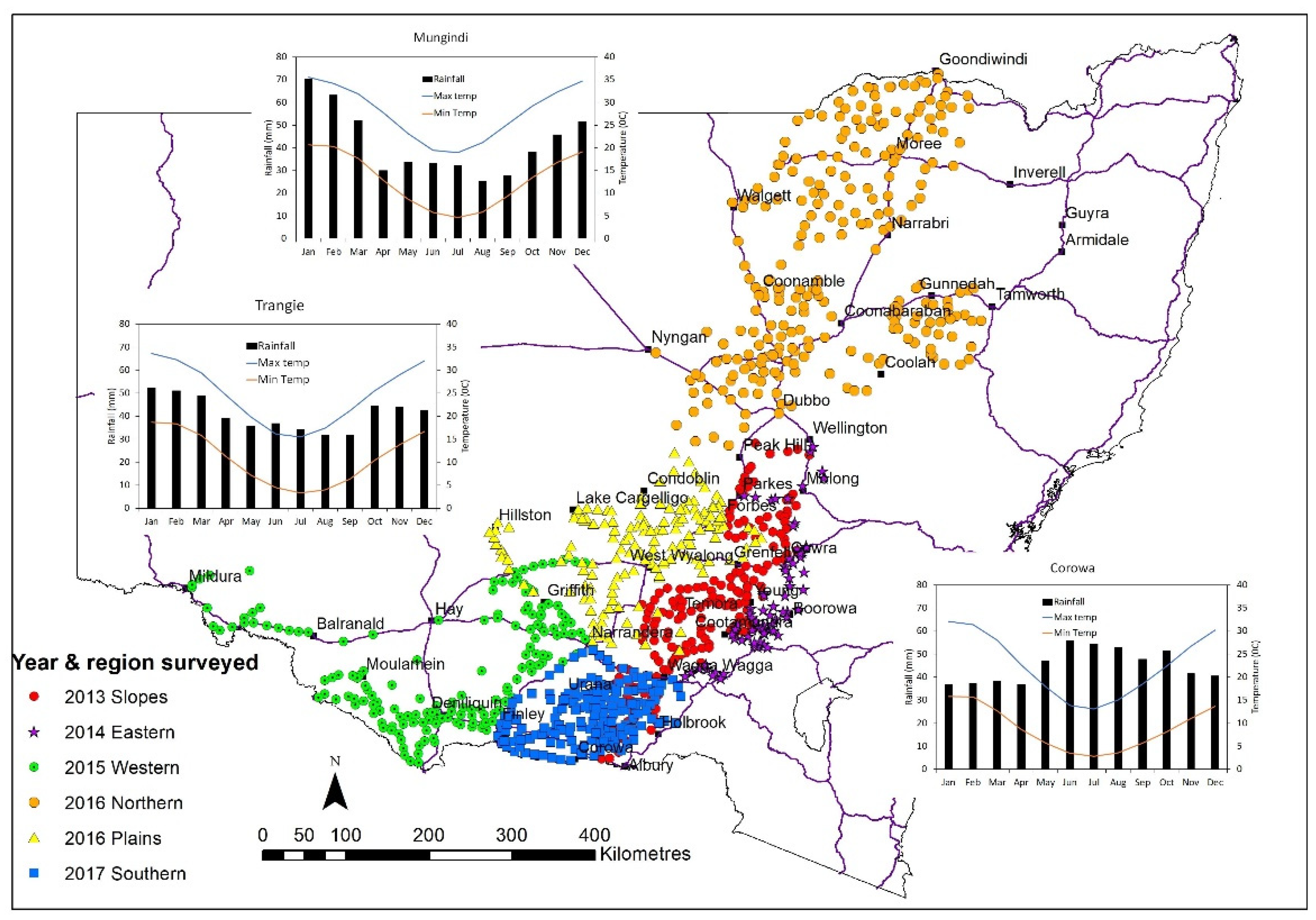
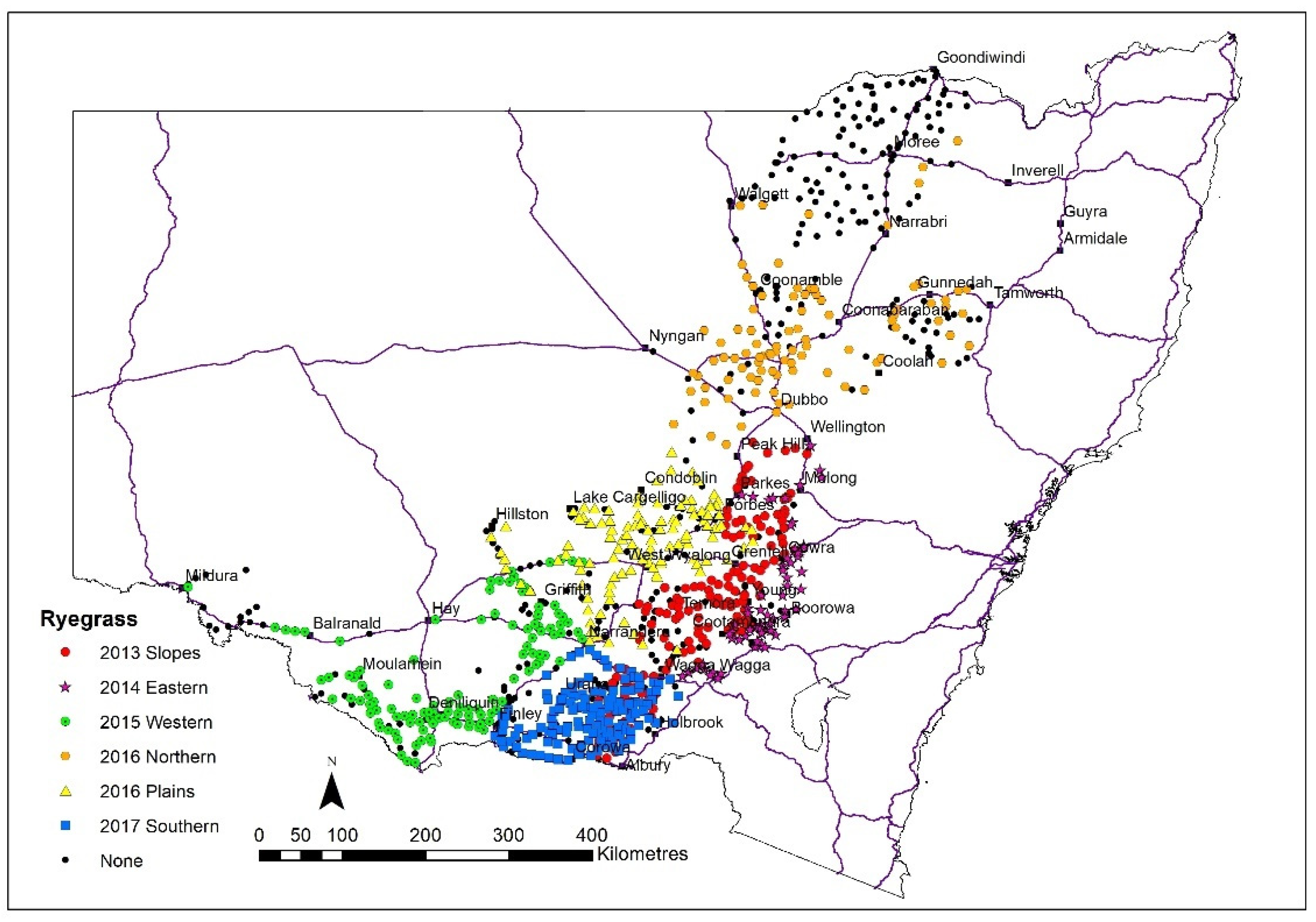

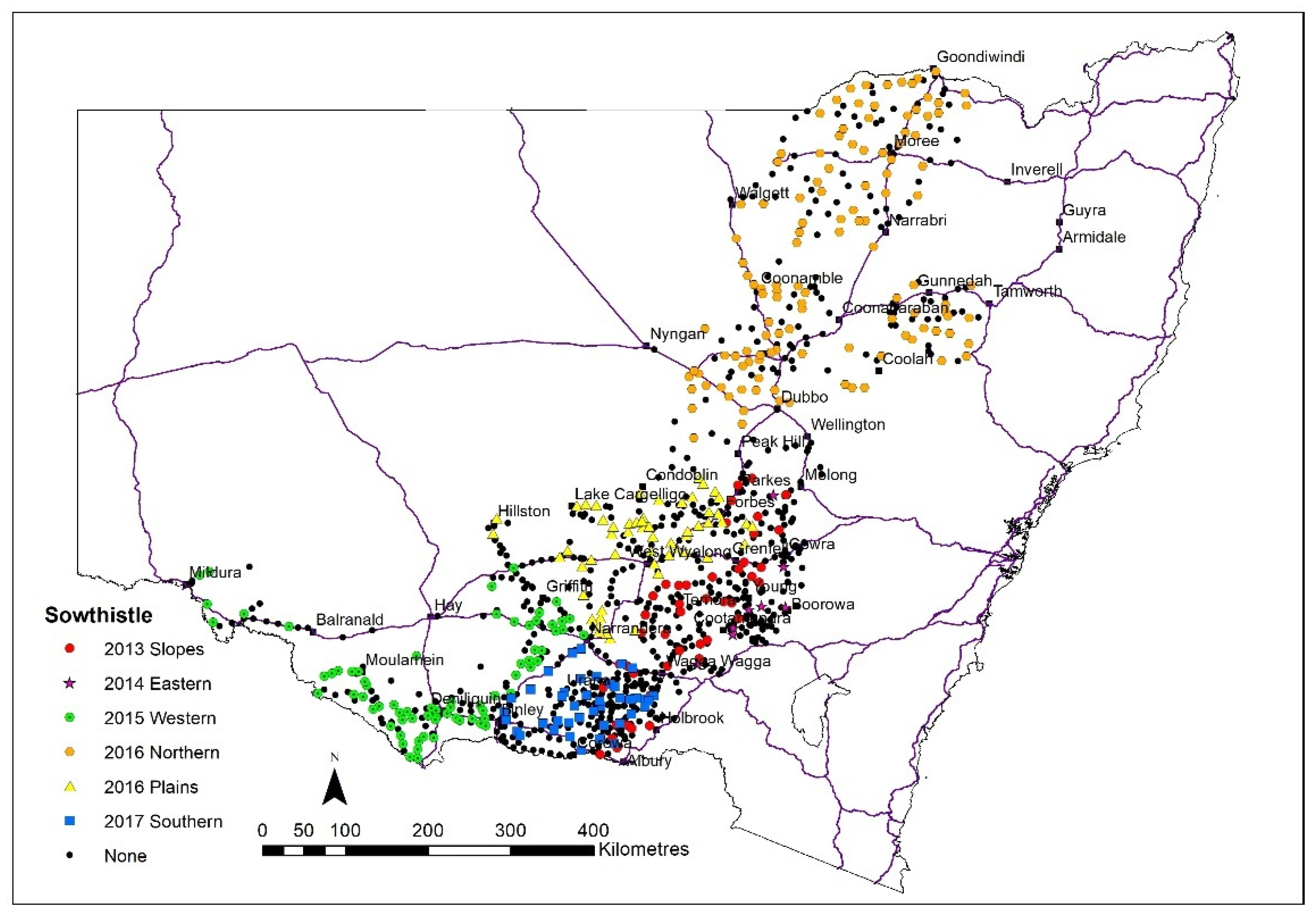
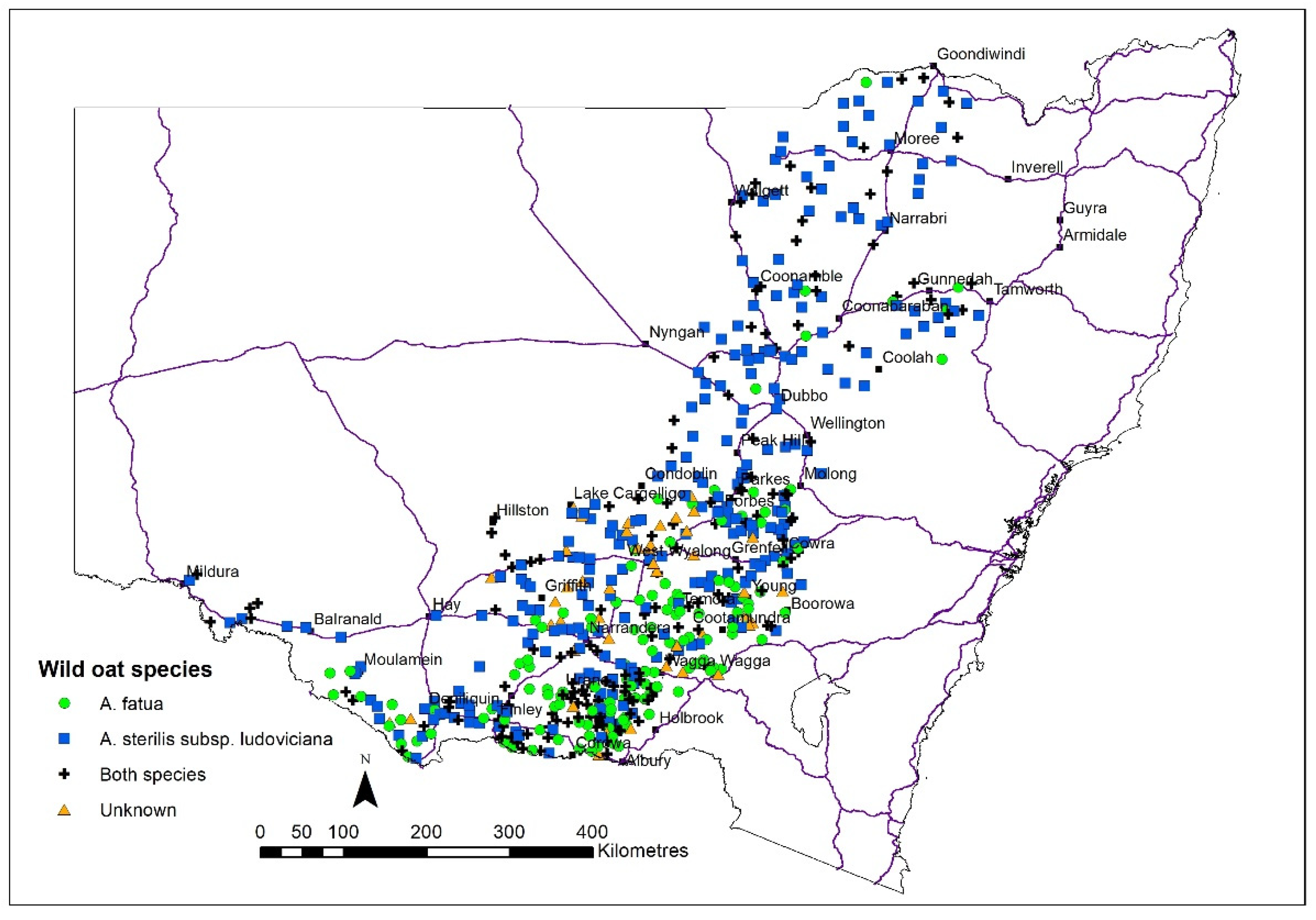
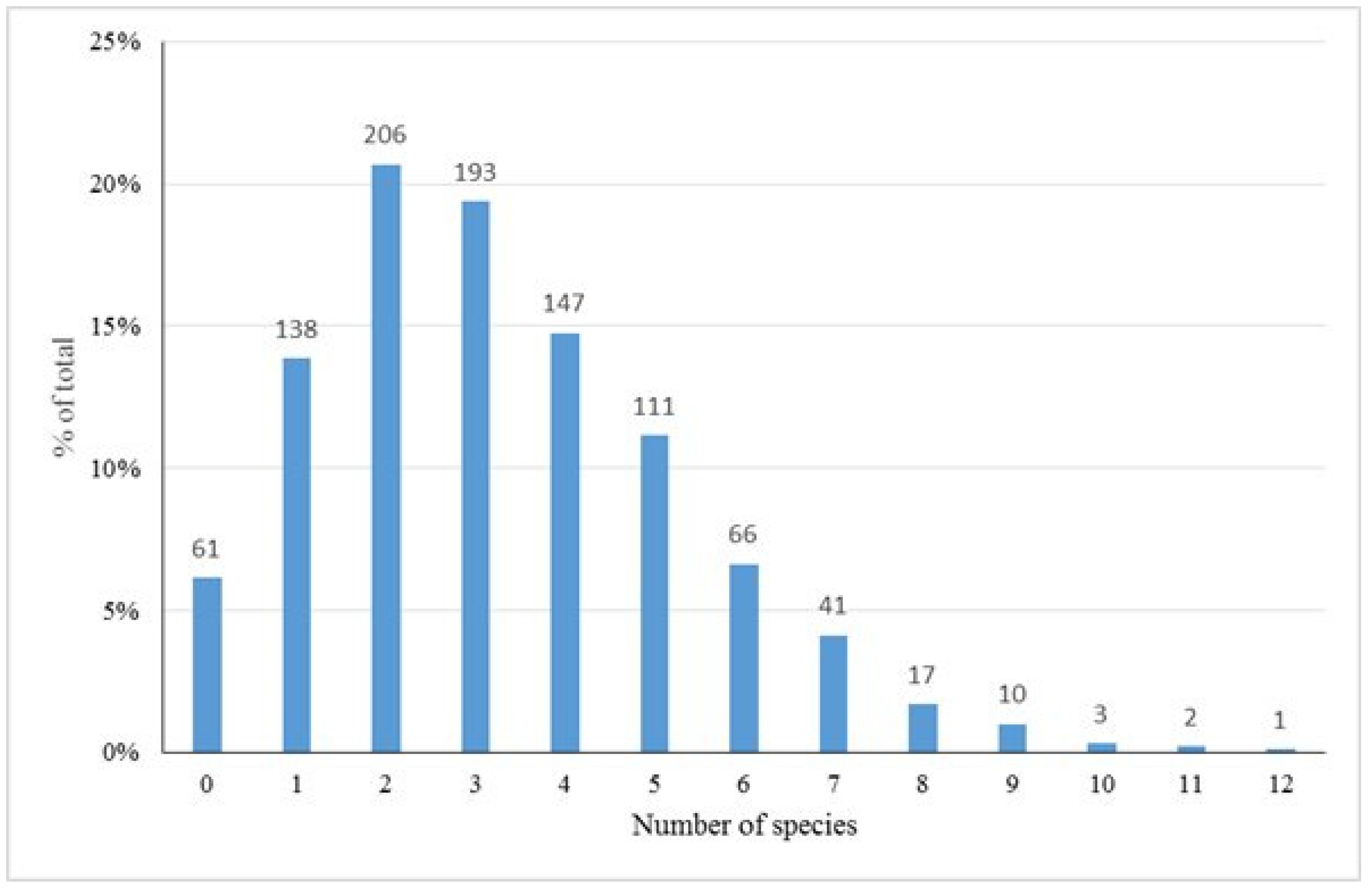
| Occurrence Ranking | NSW 2013 to 2017 | Slopes 2013 | Eastern 2014 | Western 2015 | Plains 2016 | Northern 2016 | Southern 2017 |
|---|---|---|---|---|---|---|---|
| 1 | Ryegrass (68.5) | Ryegrass (81.9) | Ryegrass (86.7) | Ryegrass (72.0) | Ryegrass (74.3) | Wild oats (53.3) | Ryegrass (81.5) |
| 2 | Wild oats (59.9) | Wild oats (67.8) | Wild oats (50.7) | Wild oats (59.1) | Wild oats (57.2) | Sow thistle (48.8) | Wild oats (67.9) |
| 3 | Sow thistle (34.2) | Barley grass (24.6) | Barley grass (16.0) | Sow thistle (43.9) | Sow thistle (36.8) | Ryegrass (37.7) | Sow thistle (25.3) |
| 4 | Barley grass (17.0) | Brome grass (23.6) | Brome grass (16.0) | Barley grass (36.6) | Prickly lettuce (23.0) | Fleabane (22.1) | Brome grass (13.6) |
| 5 | Wireweed (15.4) | Sow thistle (22.6) | Silver grass (16.0) | Wireweed (28.7) | Silver grass (20.4) | Wireweed (20.1) | Barley grass (8.6) |
| 6 | Prickly lettuce (13.8) | Silver grass (19.6) | Sow thistle (10.7) | Brome grass (19.5) | Fleabane (17.1) | Wild turnip (18.9) | Wireweed (8.6) |
| 7 | Brome grass (13.0) | Prickly lettuce (14.6) | Shepherd’s purse (9.3) | IHM* (18.3) | Toad rush (16.4) | Prickly lettuce (14.3) | Silver grass (7.4) |
| 8 | Fleabane (12.4) | Wireweed (10.6) | Wild radish (9.3) | Fleabane (15.2) | Skeleton weed (13.8) | Bluebell (10.2) | Wild radish (7.4) |
| 9 | Silver grass (11.3) | Skeleton weed (6.5) | Prickly lettuce (6.7) | Prickly lettuce (14.0) | Wireweed (12.5) | Phalaris (9.8) | Fleabane (7.4) |
| 10 | Skeleton weed, IHM * (5.4) | Mallow (4.0) | Wireweed (5.3) | Phalaris (12.8) | IHM *, Paterson’s curse, Cudweed (11.8) | Chloris spp., Cudweed (9.0) | Prickly lettuce (6.8) |
| Slopes | Eastern | Western | Plains | Northern | Southern | |
|---|---|---|---|---|---|---|
| Ryegrass | <0.0001 | 0.0003 | 0.4 | 0.138 | <0.0001 | 0.0002 |
| Wild oats | 0.025 | 0.125 | 0.8874 | 0.509 | 0.037 | <0.0001 |
| Sowthistle | 0.0004 | <0.0001 | 0.011 | 0.442 | <0.0001 | 0.016 |
| Barley grass | 0.006 | 1.0 | <0.0001 | 0.031 | <0.0001 | 0.00323 |
| Wireweed | 0.062 | 0.01 | <0.0001 | 0.369 | 0.052 | 0.016 |
| Prickly lettuce | 0.759 | 0.092 | 0.91 | 0.0022 | 0.853 | 0.0062 |
| Brome grass | <0.0001 | 0.499 | 0.02 | 0.015 | <0.0001 | 0.816 |
| Fleabane | <0.0001 | 0.0012 | 0.285 | 0.084 | <0.0001 | 0.056 |
| Silver grass | 0.0007 | 0.2 | 0.137 | 0.0007 | <0.0001 | 0.136 |
| Skeleton weed | 0.433 | ** | 0.728 | <0.0001 | 0.0063 | 0.727 |
| IHM * | 0.028 | ** | <0.0001 | 0.0062 | 0.0015 | 0.226 |
| Wild radish | 0.859 | ** | 0.051 | 0.838 | 0.873 | 0.049 |
| Species | Population Density | Total Populations | ||||
|---|---|---|---|---|---|---|
| <1 10m−2 | <1 m−2 | 1–10 m−2 | >10 m−2 | >50 m−2 | ||
| Proportion of Populations (%) | ||||||
| Ryegrass | 33.4 | 26.4 | 21.5 | 13.5 | 5.3 | 683 |
| Wild oats | 43.7 | 33.8 | 16.1 | 5.5 | 0.8 | 597 |
| Sow thistle | 59.8 | 30.8 | 8.2 | 1.2 | 0 | 341 |
| All species | 48.5 | 29.0 | 15.2 | 5.8 | 1.5 | 3271 |
| Difference from Expected (YY * and NN * Combined) | |||||||
|---|---|---|---|---|---|---|---|
| Species 1 | Species 2 | >10% | 5% to 10% | 0% to 5% | 0% to −5% | −5% to −10% | >−10% |
| Grass | Grass | 3 | 3 | 3 | 1 | 0 | 0 |
| Broadleaf | Broadleaf | 2 | 3 | 8 | 4 | 0 | 0 |
| Grass | Broadleaf | 0 | 1 | 17 | 14 | 2 | 0 |
| Slopes 2013 | Eastern 2014 | Western 2015 | Plains 2016 | Northern 2016 | Southern 2017 | NSW Total | |
|---|---|---|---|---|---|---|---|
| Wheat | 86.9 | 64.0 | 54.3 | 65.1 | 45.9 | 59.3 | 61.9 |
| Barley | 7.0 | 1.3 | 17.7 | 15.8 | 18.4 | 5.6 | 12.2 |
| Canola | 0.5 | 6.7 | 6.7 | 3.9 | 1.6 | 17.9 | 5.6 |
| Oats | 0.5 | 4.0 | 6.1 | 8.6 | 6.6 | 5.6 | 5.2 |
| Pulse | 4.0 | 2.7 | 6.7 | 1.3 | 25.8 | 3.7 | 9.2 |
| Pasture | 0.0 | 12.0 | 8.5 | 4.6 | 0.8 | 5.6 | 4.1 |
| Undersown | 0.0 | 8.0 | 0.0 | 0.0 | 0.0 | 1.2 | 0.8 |
| Other | 1.0 | 1.3 | 0.0 | 0.7 | 0.8 | 1.2 | 0.8 |
| Total | 199 | 75 | 164 | 152 | 244 | 162 | 996 |
| Difference from Expected (YY * Only) | |||||||
|---|---|---|---|---|---|---|---|
| Crop | Weed | > 50% | 25% to 50% | 0% to 25% | 0% to −25% | −25% to −50% | > −50% |
| Cereal | Grass | 2 | 1 | 6 | 6 | 0 | 0 |
| Broadleaf | Broadleaf | 5 | 0 | 0 | 2 | 1 | 1 |
| Cereal | Broadleaf | 1 | 2 | 5 | 7 | 2 | 0 |
| Broadleaf | Grass | 0 | 0 | 0 | 1 | 2 | 7 |
Publisher’s Note: MDPI stays neutral with regard to jurisdictional claims in published maps and institutional affiliations. |
© 2022 by the authors. Licensee MDPI, Basel, Switzerland. This article is an open access article distributed under the terms and conditions of the Creative Commons Attribution (CC BY) license (https://creativecommons.org/licenses/by/4.0/).
Share and Cite
Broster, J.C.; Chambers, A.J.; Weston, L.A.; Walsh, M.J. Annual Ryegrass (Lolium rigidum), Wild Oats (Avena spp.) and Sowthistle (Sonchus oleraceus) Are the Most Commonly Occurring Weeds in New South Wales Cropping Fields. Agronomy 2022, 12, 2914. https://doi.org/10.3390/agronomy12122914
Broster JC, Chambers AJ, Weston LA, Walsh MJ. Annual Ryegrass (Lolium rigidum), Wild Oats (Avena spp.) and Sowthistle (Sonchus oleraceus) Are the Most Commonly Occurring Weeds in New South Wales Cropping Fields. Agronomy. 2022; 12(12):2914. https://doi.org/10.3390/agronomy12122914
Chicago/Turabian StyleBroster, John C., Allison J. Chambers, Leslie A. Weston, and Michael J. Walsh. 2022. "Annual Ryegrass (Lolium rigidum), Wild Oats (Avena spp.) and Sowthistle (Sonchus oleraceus) Are the Most Commonly Occurring Weeds in New South Wales Cropping Fields" Agronomy 12, no. 12: 2914. https://doi.org/10.3390/agronomy12122914
APA StyleBroster, J. C., Chambers, A. J., Weston, L. A., & Walsh, M. J. (2022). Annual Ryegrass (Lolium rigidum), Wild Oats (Avena spp.) and Sowthistle (Sonchus oleraceus) Are the Most Commonly Occurring Weeds in New South Wales Cropping Fields. Agronomy, 12(12), 2914. https://doi.org/10.3390/agronomy12122914








